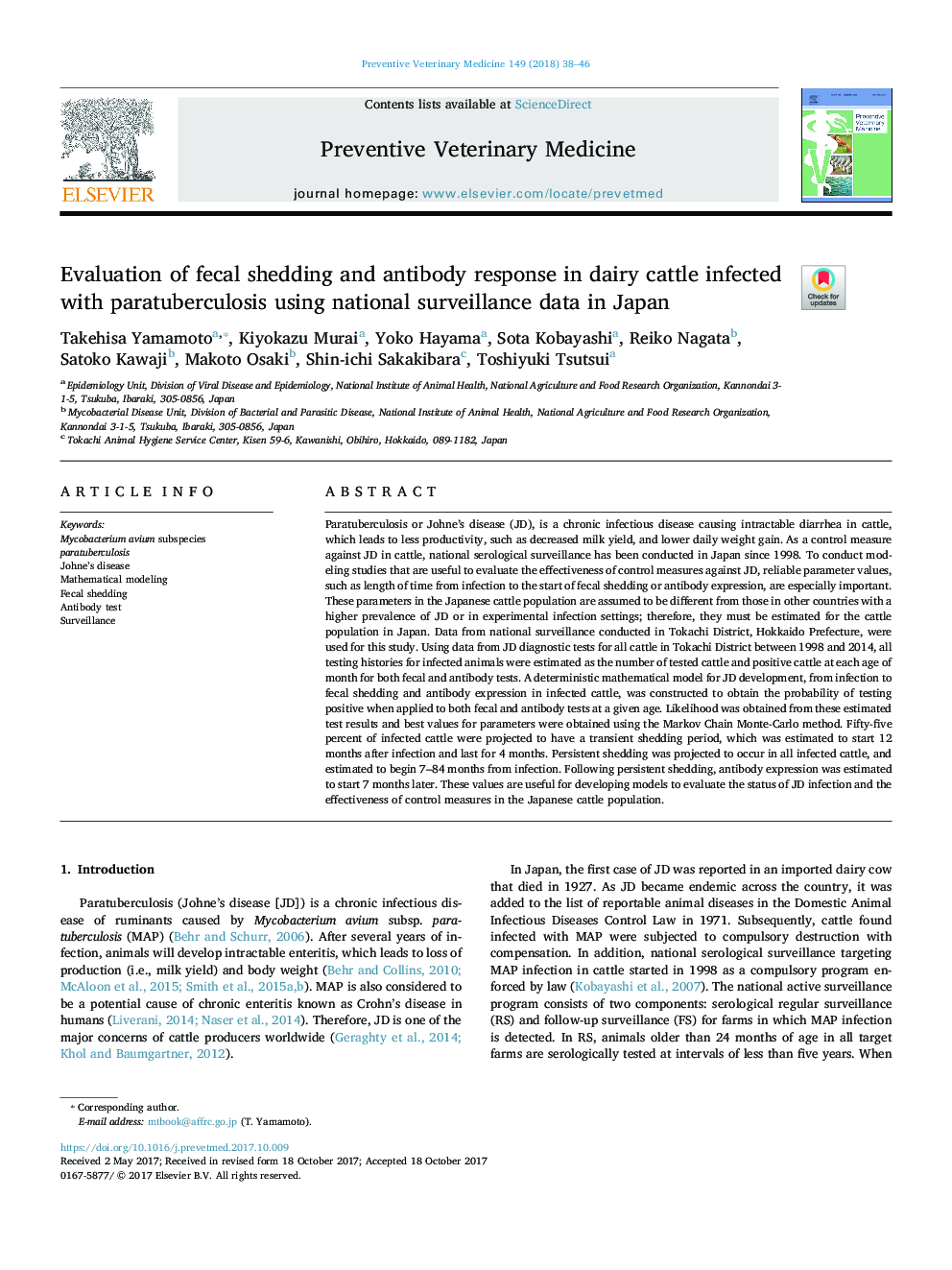| کد مقاله | کد نشریه | سال انتشار | مقاله انگلیسی | نسخه تمام متن |
|---|---|---|---|---|
| 8503595 | 1554141 | 2018 | 9 صفحه PDF | دانلود رایگان |
عنوان انگلیسی مقاله ISI
Evaluation of fecal shedding and antibody response in dairy cattle infected with paratuberculosis using national surveillance data in Japan
ترجمه فارسی عنوان
ارزیابی ریزش مدفوع و پاسخ آنتی بادی در گاوهای شیری آلوده به پاراتوبرکلوز با استفاده از داده های نظارت ملی در ژاپن
دانلود مقاله + سفارش ترجمه
دانلود مقاله ISI انگلیسی
رایگان برای ایرانیان
کلمات کلیدی
موضوعات مرتبط
علوم زیستی و بیوفناوری
علوم کشاورزی و بیولوژیک
علوم دامی و جانورشناسی
چکیده انگلیسی
Paratuberculosis or Johne's disease (JD), is a chronic infectious disease causing intractable diarrhea in cattle, which leads to less productivity, such as decreased milk yield, and lower daily weight gain. As a control measure against JD in cattle, national serological surveillance has been conducted in Japan since 1998. To conduct modeling studies that are useful to evaluate the effectiveness of control measures against JD, reliable parameter values, such as length of time from infection to the start of fecal shedding or antibody expression, are especially important. These parameters in the Japanese cattle population are assumed to be different from those in other countries with a higher prevalence of JD or in experimental infection settings; therefore, they must be estimated for the cattle population in Japan. Data from national surveillance conducted in Tokachi District, Hokkaido Prefecture, were used for this study. Using data from JD diagnostic tests for all cattle in Tokachi District between 1998 and 2014, all testing histories for infected animals were estimated as the number of tested cattle and positive cattle at each age of month for both fecal and antibody tests. A deterministic mathematical model for JD development, from infection to fecal shedding and antibody expression in infected cattle, was constructed to obtain the probability of testing positive when applied to both fecal and antibody tests at a given age. Likelihood was obtained from these estimated test results and best values for parameters were obtained using the Markov Chain Monte-Carlo method. Fifty-five percent of infected cattle were projected to have a transient shedding period, which was estimated to start 12 months after infection and last for 4 months. Persistent shedding was projected to occur in all infected cattle, and estimated to begin 7-84 months from infection. Following persistent shedding, antibody expression was estimated to start 7 months later. These values are useful for developing models to evaluate the status of JD infection and the effectiveness of control measures in the Japanese cattle population.
ناشر
Database: Elsevier - ScienceDirect (ساینس دایرکت)
Journal: Preventive Veterinary Medicine - Volume 149, 1 January 2018, Pages 38-46
Journal: Preventive Veterinary Medicine - Volume 149, 1 January 2018, Pages 38-46
نویسندگان
Takehisa Yamamoto, Kiyokazu Murai, Yoko Hayama, Sota Kobayashi, Reiko Nagata, Satoko Kawaji, Makoto Osaki, Shin-ichi Sakakibara, Toshiyuki Tsutsui,
